When data is surfaced, organized, analyzed, and applied effectively, you have the power to delight more customers and improve your business’s bottom line. But first, you need to obtain all of that valuable information.
A common way to collect data related to the metrics that you care most about — such as churn, conversion rate, engagement rate, user activation rate, and average revenue per customer — is through the process of data tracking.
Data Tracking
To obtain meaningful data about your customers and target audience and their behaviors, you need to track the metrics that matter most to your business both accurately and securely.
In this article, we’ll talk about what data tracking is, why it’s beneficial, how it works, and which tools can help you track and analyze the metrics you care about.
How does data tracking work?
Data tracking and collection are often performed with cookies and/or Javascript libraries. This is how a business can track information about user behaviors on the various pages of your website (e.g. web page, landing page, blog article, product page, checkout page, etc.) as well as user/ customer accounts.
There are several tools available (we’ll look at some examples shortly) that use cookies and Javascript to track data.
For instance, Google uses Javascript to measure how users interact with your website, HubSpot uses cookies to monitor website traffic (on your landing pages, blogs, and web pages) and track visitors, and Segment uses cookies and Javascript to analyze site traffic, deliver personalized ads, and improve browsing experiences.
How to Choose the Metrics You'll Track
The key to data tracking is selecting the right metrics (a.k.a. what you’re actually going to be measuring).
- Ask yourself questions about what it is you want to learn. For example, "Which version of my product page converts the most users?"
- Then, turn your question into a metric. For the example in the above step, your metric could be a product page’s conversion rate based on page views.
- Hone in on your metric of choice even more by indicating the "events" within that metric. For the above example, events could be: 1) when a visitor lands on a product page, 2) when a visitor clicks the CTA on a product page, 3) when a user completes a form or submits a request to speak with a rep on a product page, 4) when a visitor converts into a paid customer on a product page.
- Your chosen metrics and events should help you prove a strategy either works or doesn't among your audience. In other words, you can use your resulting data to prove your strategy's impact on the business and revenue.
Data Tracking Compliance
Now that you have a basic understanding of what data tracking is, you might be wondering about General Data Protection Regulation (GDPR), privacy policies, and the laws that exist to protect visitors, contacts, and customers.
How to Comply with Data Tracking Policies and Laws
Today, businesses should share information with customers and visitors about how they comply with these regulations.
For instance, here's Segment's website data collection compliance explanation:
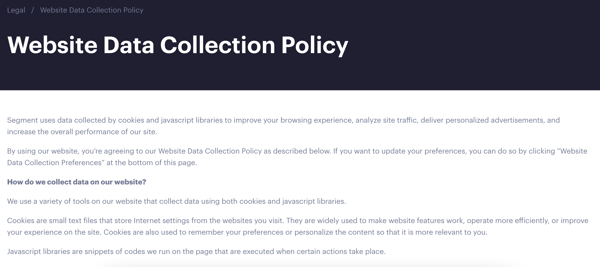 On the web page, Segment clearly lays out how they collect and use data and contact details that are tracked with cookies and Javascript libraries on their website.
On the web page, Segment clearly lays out how they collect and use data and contact details that are tracked with cookies and Javascript libraries on their website.
If you're worried about the potential of not covering all of your bases when it comes to compliance, there's good news — many data tracking tools help you with this process.
Note: There isn't a one-size-fits-all solution to legal compliance. That's why — in addition to implementing a data tracking tool — it's recommended that you consult your legal team on compliance. They will be able to help you apply the relevant features of your data tracking tool and determine what compliance at your company looks like.
For instance, HubSpot has a web page that explains in detail how GDPR works and how every HubSpot customer can feel confident that their website is compliant.
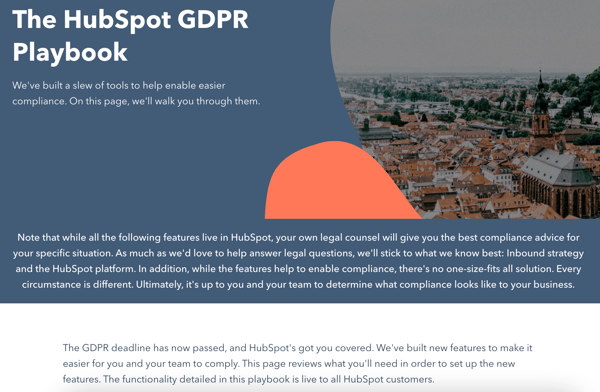 Here are examples of how HubSpot helps you ensure data tracking and application are compliant:
Here are examples of how HubSpot helps you ensure data tracking and application are compliant:
1. Cookies
GDPR requires you to tell your website visitors that you're using cookies on your website in a language that they understand. They then need to consent to that tracking.
HubSpot allows you to capture all of your visitors' cookie tracking consent and you can share different versions of your consent banner on your web pages.
2. Lawful Basis
GDPR requires you to have lawful basis to use someone's data. HubSpot categorizes lawful reason to use someone's data by your intent to either use it to 1) process or 2) communicate.
HubSpot has a default contact property to store lawful basis to process and there's an option to track opt-ins and opt-outs to store lawful basis to communicate.
3. Deletion
Under GDRP, your contacts have the ability to ask you to give them a copy of all of the personal data you have about them. They can also ask you to modify that information or delete it completely.
HubSpot makes this easy by offering a "GDPR delete" function which permanently deletes a contact for you.
Data Tracking Software
Did you know that operations teams spend 80% of their time putting out data and process fires and only 20% driving business strategy and improving the customer experience?
With the right tools, things don’t have to be this way — your team can feel confident that your data is being tracked automatically, accurately, efficiently, and securely.
1. HubSpot Operations Hub
Best data tracking tool for combining a complete operations platform with a CRM to integrate all customer data across your business.
Price: $0/month (Free), $45/month (Starter), $720/month (Professional)
According to HubSpot’s Principal Marketing Manager, Ari Plaut, “Operation Hub’s key differentiator is that HubSpot is also a CRM.” Today, many data tracking tools allow you to track and analyze data — however, they don't let you do anything else with that data.
For example, with pretty much any data tracking tool on the market, you can track your customers to help you understand your activation rate.
However, if you want to then send an email to the customers who haven't activated to show them how they can get started, you aren't able to with most data tracking tools. But with Operations Hub you are.
Operations Hub increases HubSpot’s already powerful capabilities by making it easy for users to connect, clean, and automate customer data across the entire business.
Unique features:
- Sync data without code (e.g. bidirectional sync, custom field mappings, filtering, historical syncing).
- Automate data cleaning and run code-based actions with Advanced Workflow Automation.
- Build fully-native custom applications with Custom Objects.
- Install the HubSpot tracking code to monitor website traffic on your landing pages, blogs, and web pages.
- Track and manage your data with local regulations in mind (e.g. GDPR deletion, consent and cookies, and lawful basis processing).
- Keep data secure with SSL, SSO, two-factor authentication, and more.
2. Google Analytics
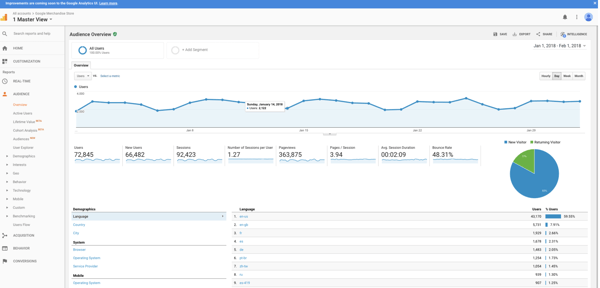
Best data tracking tool for tracking website engagement, audience behaviors, and digital marketing campaigns for free.
Price: Free (for under 10 million or fewer hits per month).
By adding the Google Analytics JavaScript tracking code to your web pages, you'll have the insights necessary to improve the customer experience and identify the right messaging, channels, and content for your target audience across your website and app.
There are a number of customizable metrics that you can track with Google Analytics such as sessions, engagement, entry and exit pages, events, retention, return, conversions, and more.
As for reporting and tracking specifically, track custom events, attribution, user path, and user activity all in real-time via a single dashboard.
Unique features:
- Collect user session and ad campaign data from page requests by setting and reading first-party cookies on your users' browsers.
- Read the DoubleClick cookie to collect data on display features.
- Use Google's Events to collect data (such as downloads, link clicks, form submissions, etc.) about interactions with your content.
- Use Google's Event Goals to define a certain Event as a conversion.
- Decide how you want to configure your Google Analytics tracking code so it's tailored to your unique website.
- Build custom reports and dashboards to track your Events.
- Collect user-specific data while they're on your website such as location, language, and activity.
3. Segment
Best data tracking tool for implementing a CDP that can track, collect, align, and route all of your customer data into any system.
Price: Free, $120+/month (Team), request a custom demo (Business)
Segment is a data collection, management, and analytics platform. It powers and integrates with all of your data tracking tools in and out of Segment to keep your teams aligned.
There are also GDPR, CCPA, and other privacy regulations to help you maintain data compliance.
Segment uses its API to collect data from any part of your product (e.g. mobile, web, server) via open source libraries for all platforms.
Unique features:
- Integrate your data with over 300 available apps in minutes.
- Use the event tracking API to track user events and record the actions those visitors perform on any platform.
- Query data in SQL and easily access your data at any time by using Segment's APIs.
- Keep all of your analytics data in a data warehouse of your choosing (e.g. Google BigQuery, Snowflake, etc.).
- Automatically back up your data and download your data whenever and wherever you need to.
- Access your user profiles in real-time.
- Use the Segment Profile API to review user- and account-level customer data.
4. Emarsys
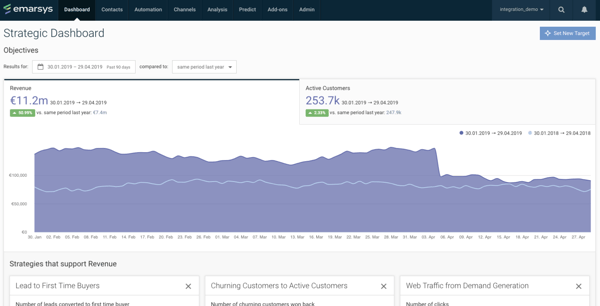
Best data tracking tool for collecting product and behavior data and making that information accessible across the Emarsys platform.
Price: Request a demo and/or pricing.
Emarsys' website data collection tool, Web Extend, establishes one-to-one personalization capabilities across different channels. It uses cookies and JavaScript API commands to keep track of your website visitors and their behaviors.
Emarsys tracks visitor interactions and behaviors across your website — from product catalog to online store — and combines that information with your historical sales data (if you have any) to give you a holistic view of your audience.
Then, the tool adds your data to the various Emarsys systems within the platform such as the Revenue Attribution and Automation Center systems. This way, you can share your data cross-team and -department as well as reference and apply it throughout all business decisions.
Unique features:
- Track the type of customer data you need to create personalized experiences across all of your channels.
- Use cross-device user identification and campaign tracking.
- Track your known-contact interactions on your website and sync that data into the Emarsys contact database (which automatically happens every few hours).
- Access your data via any of the systems within the Emarsys platform, so you never have to integrate it.
- Track revenue from email campaigns with the Revenue Attribution system.
- Build campaigns based on contact behavior with the Automations system.
- Apply your catalog and purchase data to customer and lifecycle segmentation with the Smart Insight system.
Choose Your Metrics and Tool, and Begin Data Tracking
Data tracking is an effective and accurate way to identify and track the most important metrics to your business — you can then apply your results and insights to improve the customer experience and your bottom line.
Data Tracking: What Is It and What Are the Best Tools was originally posted by Local Sign Company Irvine, Ca. https://goo.gl/4NmUQV https://goo.gl/bQ1zHR http://www.pearltrees.com/anaheimsigns

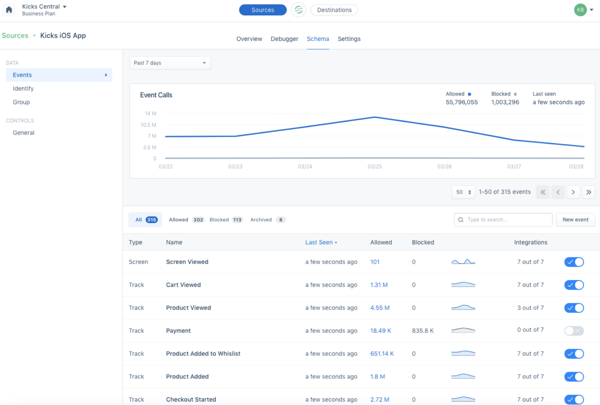
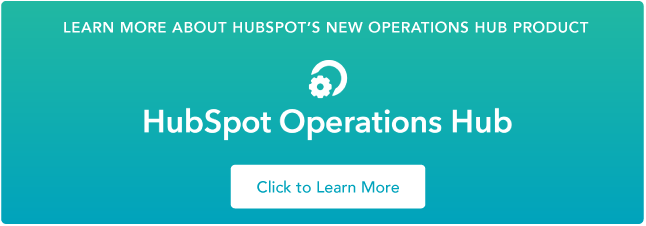
No comments:
Post a Comment